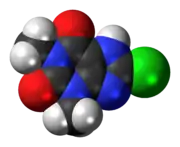8-Chlorotheophylline
8-Chlorotheophylline, also known as 1,3-dimethyl-8-chloroxanthine, is a stimulant drug of the xanthine chemical class, with physiological effects similar to caffeine.[1] Its main use is in combination (salt) with diphenhydramine in the antiemetic dimenhydrinate (Dramamine). Diphenhydramine reduces nausea but causes drowsiness, and the stimulant properties of 8-Chlorotheophylline help reduce that side effect.[2]
 | |
 | |
| Clinical data | |
|---|---|
| Routes of administration | Oral |
| ATC code |
|
| Legal status | |
| Legal status |
|
| Identifiers | |
| |
| CAS Number | |
| PubChem CID | |
| ChemSpider | |
| UNII | |
| ChEBI | |
| ChEMBL | |
| CompTox Dashboard (EPA) | |
| ECHA InfoCard | 100.001.446 |
| Chemical and physical data | |
| Formula | C7H7ClN4O2 |
| Molar mass | 214.61 g·mol−1 |
| 3D model (JSmol) | |
| |
| |
| | |
Despite being classified as a xanthine stimulant, 8-chlorotheophylline can generally not produce any locomotor activity above control in mice and does not appear to cross the blood-brain barrier well.
The 8-chloro modification is not selected for pharmacological properties; instead, it was to raise the acidity of the xanthine amine group enough to form a co-salt with diphenhydramine.[2]
The drug is also sold in combination with promethazine, again as a salt.[3]
References
- Snyder SH, Katims JJ, Annau Z, Bruns RF, Daly JW (May 1981). "Adenosine receptors and behavioral actions of methylxanthines". Proceedings of the National Academy of Sciences of the United States of America. 78 (5): 3260–4. Bibcode:1981PNAS...78.3260S. doi:10.1073/pnas.78.5.3260. PMC 319541. PMID 6265942.
- Cusic, John W. (3 June 1949). "Note on the Chemistry of Dramamine". Science. 109 (2840): 574–574. doi:10.1126/science.109.2840.574.a.
- https://www.ebi.ac.uk/chebi/searchId.do?chebiId=8461 "The anti-emetic action of both the hydrochloride and the teoclate (8-chlorotheophylline) salts is used for the prevention of nausea in cases of motion sickness and post-operative vomiting."